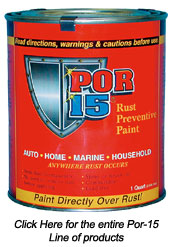1. Why is POR-15 different?
Many products claim to stop rust; some are paints, some are conversion products, some are rust treatments. None seem to really stop rust permanently. Why is POR-15 different, and why should I believe it will work any better?
Rust is caused by moisture coming in contact with metal, which causes a chemical action called oxidation. All paints provide a measure of protection for a while, but since they are eventually softened and weakened by moisture, it is only a matter of time before moisture penetrates the painted surface and attacks
 the metal below. All of the so-called rust preventive paints on the market (except POR-15) are weakened by exposure to moisture. POR-15 is strengthened by exposure to moisture. Notice the hardness of the POR-15 coating. It doesn't chip, crack, or peel like ordinary paints do, and its hardness will resist the wear and tear of every day life.
the metal below. All of the so-called rust preventive paints on the market (except POR-15) are weakened by exposure to moisture. POR-15 is strengthened by exposure to moisture. Notice the hardness of the POR-15 coating. It doesn't chip, crack, or peel like ordinary paints do, and its hardness will resist the wear and tear of every day life.
Rust conversion products claim to change the chemical nature of rust and convert it to a more stable element that won't rust again. History of the failure of these products is well documented; most simply don't work for more than a few months at best, and they are subject to the same chipping and cracking that occurs with ordinary rust coatings.
POR-15 works because it chemically bonds to rusted metal and forms a rock- hard, non-porous coating that won't crack, chip, or peel. It keeps moisture away from metal with a coating that is strengthened by continued exposure to moisture.
2. Is it better to brush or spray POR-15?
Most people brush it on, but many spray also. Proper equipment and organic vapor particulate respirators for solvents are essential for spraying.
3. How do I thin POR-15 if I want to spray it?
You should use only POR-15 Solvent for thinning. Keep lacquer thinner handy for clean-up. Do not thin POR-15 more than 5%.
4. Can I apply POR-15 over other paints?
Yes, but you will lose the important benefits of POR-15. You must remember that ordinary paints are weakened by exposure to moisture. POR-15 can't stop rust if it isn't in direct contact with the base metal.
5. Is it dangerous to get POR-15 on my hands?
No, but if you do, remove it at once with solvent or lacquer thinner. If POR-15 dries on your skin, nothing will take it off, and you will 'wear' it for 3 or 4 days until natural oils and flaking skin remove it.
6. Are POR-15 vapors dangerous to my health?
Yes. That's why you must always paint in a well-ventilated area and keep your nose away from the paint container. POR-15 is not dangerous if you follow our simple directions.
7. What is the best surface on which to paint POR-15?
POR-15 likes rusted surfaces best. Seasoned metal and sandblasted metal are also good. POR-15 does not adhere well to smooth, shiny surfaces, but will adhere well to those surfaces with the proper preparation.
8. Can I paint over POR-15 with other paints?
Absolutely. POR-15 will accept all paints, including lacquer-based paints. POR-15 Tie-Coat Primer is the best prime coat to use before topcoating POR-15. Be sure to read thoroughly our directions and tip sheets regarding topcoating before using POR-15.
9. Can I use body filler or putty with POR-15?
Yes. First paint both sides of the rusted area with POR-15; then use body filler or putty as soon as the POR-15 is dry to the touch.
10. How long does it take POR-15 to dry?
That depends on the ambient humidity (surrounding area). The more humid the area, the faster the dry time, which usually varies from 3 to 6 hours.
11. Can POR-15 be used with fiberglass?
Absolutely. POR-15 is fully compatible with fiberglass and can be used to repair cracks in gelcoat. It will adhere better than polyester resin and has greater strength. Use also with fiberglass cloth to make super-strong surfaces in rusted-out areas. But be aware that POR-15 doesn't contain styrene and thus cannot melt fiberglass cloth like polyester resin does.
12. What is the 'proper preparation'?
We make a product called 'Metal-Ready'. It's a rust remover that leaves a zinc phosphate coating on base metal, the perfect preprimer for POR-15. NOTE: New steel is coated with a protective oil finish at the mill. This finish must be removed before using POR-15 or Metal-Ready. Clean metal first with POR-15 Marine-Clean, then rinse with water and dry.
13. Which POR-15 (Black/Silver/Gray) should I use?
Silver contains metal filler and should be used in badly rusted, pitted areas. It will fill in holes better than black or clear. Black is generally used on frames, underside of fenders, etc. because that's the usual color there. Clear renders the smoothest finish and is often used as a preprimer on exterior surfaces; Gray is great on concrete floors, bilges, storage areas, as well as steel.
14. Must I paint over POR-15 to make it last?
No, but POR-15 has an ultra-violet sensitivity and must be topcoated if continually exposed to sunlight. Once topcoated, POR-15 will remain effective for many years.
15. Will the sun destroy POR-15 coating if I don't topcoat it?
No, your POR-15 protection will remain, but the sun will change its appearance cosmetically. That's why we recommend you topcoat it.












